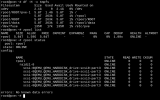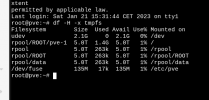From what I have read, I understand that ZFS is a lot faster than EXT4, so I want to give it a try. I do not need RAID redundancy, because it is only a homelab that does not run any critical applications. And in case of troubles, I have Ansible playbooks to set up all my containers and VM's from scratch.
Currently I am using LVM to combine several disks into volumes. Two 1Tb nvme ssd's, together a 2Tb volume for the base Proxmox local and local-lvm. Two other ssd's together form a 4Tb data volume, and finally a few old spinning hard disks together in a 5Tb logical volume for backups and so.
Are ZFS pools similar to logical volumes in LVM? So that I can create kind of the same setup with ZFS Raid0?
My system has a Ryzen 9 3900X (24cpu) processor and 64Gb ram.
Would it be worth to start from scratch and try ZFS?
Currently I am using LVM to combine several disks into volumes. Two 1Tb nvme ssd's, together a 2Tb volume for the base Proxmox local and local-lvm. Two other ssd's together form a 4Tb data volume, and finally a few old spinning hard disks together in a 5Tb logical volume for backups and so.
Are ZFS pools similar to logical volumes in LVM? So that I can create kind of the same setup with ZFS Raid0?
My system has a Ryzen 9 3900X (24cpu) processor and 64Gb ram.
Would it be worth to start from scratch and try ZFS?




